Profliand
On this page, you find all documents, package deals, and flashcards offered by seller profliand.
- 69
- 0
- 5
Community
- Followers
- Following
1 Reviews received
74 items
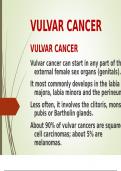
Vulvar Cancer
VULVAR CANCER Vulvar cancer can start in any part of the external female sex organs (genitals). It most commonly develops in the labia majora, labia minora and the perineum. Less often, it involves the clitoris, mons pubis or Bartholin glands. About 90% of vulvar cancers are squamous cell carcinomas; about 5% are melanomas. VULVAR CANCER Vulvar cancer may spread: By direct extension (eg, into the urethra, bladder, vagina, perineum, anus, or rectum) Through the bloodstr...
- Class notes
- • 15 pages •
VULVAR CANCER Vulvar cancer can start in any part of the external female sex organs (genitals). It most commonly develops in the labia majora, labia minora and the perineum. Less often, it involves the clitoris, mons pubis or Bartholin glands. About 90% of vulvar cancers are squamous cell carcinomas; about 5% are melanomas. VULVAR CANCER Vulvar cancer may spread: By direct extension (eg, into the urethra, bladder, vagina, perineum, anus, or rectum) Through the bloodstr...
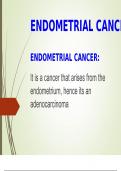
Endometrial Cancer
ENDOMETRIAL CANCER: It is a cancer that arises from the endometrium, hence its an adenocarcinoma It is a gynecological malignancy associated with low mortality rate and approximately 75% survival rate. Common in women aged between 50 and 70 years ENDOMETRIAL CANCER: Predisposing factors 1. Hyperestrogenism – this occurs with; • Obesity – this increases endogenous estrogen production • Early menarche • Late menopause • Anovulation • Nulliparous • Estrogen repl...
- Class notes
- • 11 pages •
ENDOMETRIAL CANCER: It is a cancer that arises from the endometrium, hence its an adenocarcinoma It is a gynecological malignancy associated with low mortality rate and approximately 75% survival rate. Common in women aged between 50 and 70 years ENDOMETRIAL CANCER: Predisposing factors 1. Hyperestrogenism – this occurs with; • Obesity – this increases endogenous estrogen production • Early menarche • Late menopause • Anovulation • Nulliparous • Estrogen repl...
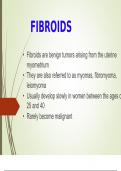
Fibroids
• Fibroids are benign tumors arising from the uterine myometrium • They are also referred to as myomas, fibromyoma, leiomyoma • Usually develop slowly in women between the ages of 25 and 40 • Rarely become malignant • The growth of fibroids is stimulated by ovarian hormones especially estrogen • Tend to disappear after menopause • May be asymptomatic or symptomatic • Common in African women that white • Incidence is high in the nulliparous aged between 35-50 years. FI...
- Class notes
- • 15 pages •
• Fibroids are benign tumors arising from the uterine myometrium • They are also referred to as myomas, fibromyoma, leiomyoma • Usually develop slowly in women between the ages of 25 and 40 • Rarely become malignant • The growth of fibroids is stimulated by ovarian hormones especially estrogen • Tend to disappear after menopause • May be asymptomatic or symptomatic • Common in African women that white • Incidence is high in the nulliparous aged between 35-50 years. FI...
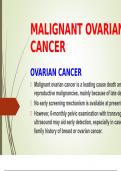
Malignant Ovarian Tumors
OVARIAN CANCER Malignant ovarian cancer is a leading cause death among the reproductive malignancies, mainly because of late detection. No early screening mechanism is available at present. However, 6-monthly pelvic examination with transvaginal ultrasound may aid early detection, especially in case of family history of breast or ovarian cancer. The cancer may be primary or as a result of metastasis of other cancers. Its common in women between 50 and 59 years and the...
- Class notes
- • 10 pages •
OVARIAN CANCER Malignant ovarian cancer is a leading cause death among the reproductive malignancies, mainly because of late detection. No early screening mechanism is available at present. However, 6-monthly pelvic examination with transvaginal ultrasound may aid early detection, especially in case of family history of breast or ovarian cancer. The cancer may be primary or as a result of metastasis of other cancers. Its common in women between 50 and 59 years and the...

Benign Ovarian Tumors
BENIGN OVARIAN TUMORS Benign ovarian tumors are either solid or cystic. They may arise from the ovum, graafian follicle, corpus luteum or ovarian epithelium They are often asymptomatic until they are large enough to cause pressure in the pelvis The cause is unknown and can become malignant BENIGN OVARIAN TUMORS: Clinical Features 1.Symptoms due to pressure on the pelvic organs; - Backache - Constipation and anorexia - Urinary frequency - A full feeling in the abdomen - Vague/dull p...
- Class notes
- • 25 pages •
BENIGN OVARIAN TUMORS Benign ovarian tumors are either solid or cystic. They may arise from the ovum, graafian follicle, corpus luteum or ovarian epithelium They are often asymptomatic until they are large enough to cause pressure in the pelvis The cause is unknown and can become malignant BENIGN OVARIAN TUMORS: Clinical Features 1.Symptoms due to pressure on the pelvic organs; - Backache - Constipation and anorexia - Urinary frequency - A full feeling in the abdomen - Vague/dull p...
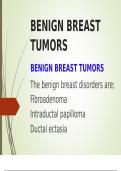
Benign Breast Tumors
BENIGN BREAST TUMORS The benign breast disorders are; Fibroadenoma Intraductal papilloma Ductal ectasia Fibrocystic breasts BENIGN BREAST TUMORS 1. FIBROADENOMA • Fibroadenoma is a benign mass of mammary glands connective tissue • Fibroadenoma is a common cause of breast lumps in women between 15 – 25 years • The key feature is a breast lump with the following characteristics: - Small about 1-3 cm in diameter - Round, solid and firm - Non tender and painless - W...
- Class notes
- • 20 pages •
BENIGN BREAST TUMORS The benign breast disorders are; Fibroadenoma Intraductal papilloma Ductal ectasia Fibrocystic breasts BENIGN BREAST TUMORS 1. FIBROADENOMA • Fibroadenoma is a benign mass of mammary glands connective tissue • Fibroadenoma is a common cause of breast lumps in women between 15 – 25 years • The key feature is a breast lump with the following characteristics: - Small about 1-3 cm in diameter - Round, solid and firm - Non tender and painless - W...
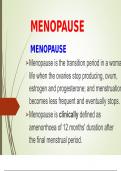
Menopause
MENOPAUSE Menopause is the transition period in a woman’s life when the ovaries stop producing, ovum, estrogen and progesterone; and menstruation becomes less frequent and eventually stops. Menopause is clinically defined as amenorrhoea of 12 months' duration after the final menstrual period. Menopause represents complete ovarian follicular depletion and the absence of estrogen secretion by the ovaries. MENOPAUSE Tobacco use, nulliparity, and family history are associated with earlier...
- Class notes
- • 19 pages •
MENOPAUSE Menopause is the transition period in a woman’s life when the ovaries stop producing, ovum, estrogen and progesterone; and menstruation becomes less frequent and eventually stops. Menopause is clinically defined as amenorrhoea of 12 months' duration after the final menstrual period. Menopause represents complete ovarian follicular depletion and the absence of estrogen secretion by the ovaries. MENOPAUSE Tobacco use, nulliparity, and family history are associated with earlier...
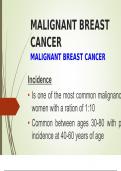
Malignant Breast Cancer
MALIGNANT BREAST CANCER Incidence • Is one of the most common malignancy in women with a ration of 1:10 • Common between ages 30-80 with peak incidence at 40-60 years of age • 1% of all breast cancers affect men while 99% affect women MALIGNANT BREAST CANCER: PREDISPOSING FACTORS 1. Age – risk increases gradually with age until 60 years. Then dramatically increases after 60 years of age 2. Hereditary factors- Family history of breast in the 1st line relatives increases the ri...
- Class notes
- • 35 pages •
MALIGNANT BREAST CANCER Incidence • Is one of the most common malignancy in women with a ration of 1:10 • Common between ages 30-80 with peak incidence at 40-60 years of age • 1% of all breast cancers affect men while 99% affect women MALIGNANT BREAST CANCER: PREDISPOSING FACTORS 1. Age – risk increases gradually with age until 60 years. Then dramatically increases after 60 years of age 2. Hereditary factors- Family history of breast in the 1st line relatives increases the ri...

Reproductive Tract fistula
REPRODUCTIVE TRACT FISTULA This refers to the presence of abnormal communication between the reproductive tract and either or both the urinary tract or GIT. REPRODUCTIVE TRACT FISTULA: CAUSES 1.Obstetric causes Prolonged labour and Obstructed labour. When labour is prolonged or obstructed, the foetal head exerts continuous pressure against the mother’s pelvis, greatly reducing the flow of blood to the soft tissues surrounding the vagina, bladder, urethra, and/or rectum. If the mothe...
- Class notes
- • 33 pages •
REPRODUCTIVE TRACT FISTULA This refers to the presence of abnormal communication between the reproductive tract and either or both the urinary tract or GIT. REPRODUCTIVE TRACT FISTULA: CAUSES 1.Obstetric causes Prolonged labour and Obstructed labour. When labour is prolonged or obstructed, the foetal head exerts continuous pressure against the mother’s pelvis, greatly reducing the flow of blood to the soft tissues surrounding the vagina, bladder, urethra, and/or rectum. If the mothe...
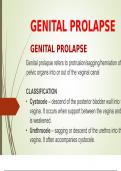
Genital Prolapse
GENITAL PROLAPSE Genital prolapse refers to protrusion/sagging/herniation of the pelvic organs into or out of the vaginal canal CLASSIFICATION • Cystocele – descend of the posterior bladder wall into the vagina. It occurs when support between the vagina and bladder is weakened. • Urethrocele – sagging or descend of the urethra into the vagina. It often accompanies cystocele. • Rectocele – a recto-vaginal hernia into the vagina. It results from weakening between the vagina ...
- Class notes
- • 14 pages •
GENITAL PROLAPSE Genital prolapse refers to protrusion/sagging/herniation of the pelvic organs into or out of the vaginal canal CLASSIFICATION • Cystocele – descend of the posterior bladder wall into the vagina. It occurs when support between the vagina and bladder is weakened. • Urethrocele – sagging or descend of the urethra into the vagina. It often accompanies cystocele. • Rectocele – a recto-vaginal hernia into the vagina. It results from weakening between the vagina ...

Driver's Ed: Chapter 7 Test Study Questions and Answers